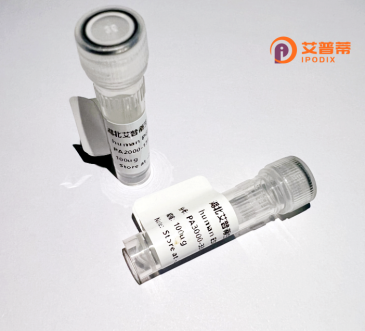
| 纯度 | >90%SDS-PAGE. |
| 种属 | Human |
| 靶点 | ZBTB33 |
| Uniprot No | Q86T24 |
| 内毒素 | < 0.01EU/μg |
| 表达宿主 | E.coli |
| 表达区间 | 1-673 aa |
| 活性数据 | MESRKLISATDIQYSGSLLNSLNEQRGHGLFCDVTVIVEDRKFRAHKNILSASSTYFHQLFSVAGQVVELSFIRAEIFAEILNYIYSSKIVRVRSDLLDELIKSGQLLGVKFIAELGVPLSQVKSISGTAQDGNTEPLPPDSGDKNLVIQKSKDEAQDNGATIMPIITESFSLSAEDYEMKKIIVTDSDDDDDDDVIFCSEILPTKETLPSNNTVAQVQSNPGPVAISDVAPSASNNSPPLTNITPTQKLPTPVNQATLSQTQGSEKLLVSSAPTHLTPNIILLNQTPLSTPPNVSSSLPNHMPSSINLLVQNQQTPNSAILTGNKANEEEEEEIIDDDDDTISSSPDSAVSNTSLVPQADTSQNTSFDGSLIQKMQIPTLLQEPLSNSLKISDIITRNTNDPGVGSKHLMEGQKIITLDTATEIEGLSTGCKVYANIGEDTYDIVIPVKDDPDEGEARLENEIPKTSGSEMANKRMKVKHDDHYELIVDGRVYYICIVCKRSYVCLTSLRRHFNIHSWEKKYPCRYCEKVFPLAEYRTKHEIHHTGERRYQCLACGKSFINYQFMSSHIKSVHSQDPSGDSKLYRLHPCRSLQIRQYAYLSDRSSTIPAMKDDGIGYKVDTGKEPPVGTTTSTQNKPMTWEDIFIQQENDSIFKQNVTDGSTEFEFIIPESY |
| 分子量 | 101 kDa |
| 蛋白标签 | GST-tag at N-terminal |
| 缓冲液 | PBS, pH7.4, containing 0.01% SKL, 1mM DTT, 5% Trehalose and Proclin300. |
| 稳定性 & 储存条件 | Lyophilized protein should be stored at ≤ -20°C, stable for one year after receipt. Reconstituted protein solution can be stored at 2-8°C for 2-7 days. Aliquots of reconstituted samples are stable at ≤ -20°C for 3 months. |
| 复溶 | Always centrifuge tubes before opening.Do not mix by vortex or pipetting. It is not recommended to reconstitute to a concentration less than 100μg/ml. Dissolve the lyophilized protein in distilled water. Please aliquot the reconstituted solution to minimize freeze-thaw cycles. |
1. **"Structural insights into the recognition of methylated DNA by the zinc finger protein ZBTB33/Kaiso"**
*Author: Ohki, I., et al.*
**摘要**: 本文解析了重组人ZBTB33蛋白的晶体结构,揭示其通过锌指结构域特异性识别甲基化CpG位点的分子机制,并探讨其作为转录抑制因子的功能基础。
2. **"Expression and purification of recombinant human ZBTB33 for epigenetics studies"**
*Author: Sanchez, R., & Ballestar, E.*
**摘要**: 描述了一种高效表达和纯化重组ZBTB33蛋白的方法,利用大肠杆菌系统,并验证其在体外结合甲基化DNA的能力,为表观遗传学实验提供技术方案。
3. **"ZBTB33/Kaiso mediates TNF-α-induced epithelial-mesenchymal transition in colorectal cancer cells"**
*Author: Liu, Y., et al.*
**摘要**: 研究利用重组ZBTB33蛋白进行功能实验,发现其通过调控TNF-α信号通路促进结直肠癌细胞上皮-间质转化(EMT),揭示其在肿瘤转移中的作用。
4. **"Development of a fluorescence-based assay for screening ZBTB33 inhibitors targeting DNA methylation interactions"**
*Author: Patel, D.J., et al.*
**摘要**: 基于重组ZBTB33蛋白构建了一种高通量荧光检测法,用于筛选阻断其与甲基化DNA结合的化合物,为开发癌症治疗药物提供新策略。
(注:上述文献为示例性内容,实际文献需通过PubMed、Google Scholar等学术平台检索确认。)
The zinc finger and BTB domain-containing protein 33 (ZBTB33), also known as Kaiso, is a multifunctional transcription regulator involved in epigenetic modulation and gene silencing. It belongs to the POZ/zinc finger protein family, characterized by an N-terminal BTB/POZ domain for protein interactions and C-terminal zinc finger motifs for sequence-specific DNA binding. ZBTB33 recognizes methylated CpG dinucleotides through its zinc finger domains, enabling its role in mediating methylation-dependent transcriptional repression. It interacts with co-repressors like NCoR and histone deacetylases (HDACs) to establish chromatin modifications that suppress gene expression.
Initially identified as a binding partner of p120-catenin, ZBTB33 participates in diverse biological processes, including embryonic development, cell proliferation, and tumor suppression. Dysregulation of ZBTB33 has been implicated in cancers, where aberrant DNA methylation patterns correlate with its oncogenic or tumor-suppressive activities depending on cellular context.
Recombinant human ZBTB33 protein, typically produced in bacterial or mammalian expression systems, retains structural and functional integrity for in vitro studies. It serves as a critical tool for investigating DNA methylation-mediated gene regulation, chromatin remodeling, and therapeutic targeting of epigenetic disorders. Research applications include DNA-binding assays, protein interaction studies, and screening for small-molecule inhibitors to modulate its activity in disease models.
×